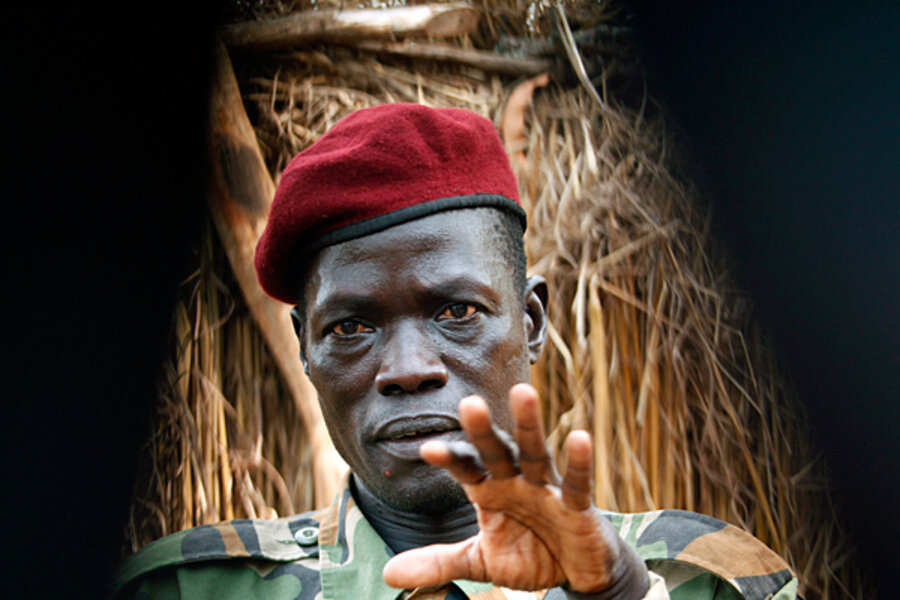Could LRA commander's capture help net Joseph Kony?
Loading...
| Djema, Central African Republic
As the Ugandan Army told it, the end of the hunt for at least one senior Lord's Resistance Army (LRA) commander was as it often is: ignominious and unexpected.
For three weeks Ugandan troops had been camped out – waiting in ambush for a suspected group of fighters from the brutal LRA that had been monitored somewhere on the other side of the river that marks the border between Central African Republic and Democratic Republic of Congo.
“Our boys were just advancing a bit, searching the area, when they came across a small path in the forest,” Jackson Kayanja, one of the commanders in charge of the operation, said. “They followed it and then suddenly, surprisingly, they found him right in front of them.”
One group of soldiers was circling in from the side and fired, Mr. Kayanja said. No one was hit.
“Then he just did this,” Kayanja said, throwing his hands up in the sign of surrender.
The gangly man standing with his hands in the air next to a woman clutching a baby and a teenage girl was Maj. Gen. Ceasar Acellam, and for the Ugandan Army this was a major coup.
Up until that point on Saturday morning, Acellam was the third-highest ranking commander in vicious warlord Joseph Kony's rebel outfit.
Now he had become the highest-ranking officer in the LRA's 25-year insurgency ever to be captured alive.
“Yesterday I did meet a group that was there on a mission,” a laconic Acellam told a small group of journalists who had been flown by the Ugandan Army to its forward base at Djema on Sunday. “I knew I was in the hands of the [Ugandan Army].”
Who is Acellam?
Recruited in 1988, just one year after Kony launched his armed insurgency to overthrow the Ugandan government and impose the biblical Ten Commandments, Acellam rose to become the LRA's intelligence chief and one of Mr. Kony's key deputies.
An erudite man – he referenced “The Art of War” in response to one journalist's question – Acellam claimed he had left his group of 30, including 14 fighters, in Congo several days earlier and was, anyway, on his way to hand himself over to the Ugandan Army.
As the Ugandan commanders sitting around him talked up his significance, he tried to play down his importance. He'd ceased being a key figure after being shot in 2002, he said. He was only a sector commander, he claimed.
But even if his influence has waned, he had to admit that his capture would send shock waves through the LRA.
“My coming out will have a big impact for the people in the bush to come out and end the war soon,” Acellam said.
Acellam's capture could see the LRA suffer more than just a hit to its morale, analysts say, and could help the Ugandan Army locate Kony.
“I think his capture will help the anti-LRA operations because he'll have the most up-to-date analysis of where specific LRA groups and commanders are, what their future plans and strategies are, and exactly how the LRA command structure has evolved in the past year,” Paul Ronan, cofounder of US-based advocacy group Resolve says.
Acellam is also an Arabic speaker and has acted as a key liaison between the LRA and its former backer – the Sudanese government, Mr. Ronan says.
Now he could also help answer the thorny question of whether Khartoum has restarted its support for Kony.
Will he talk?
And the Ugandan Army might be hopeful of getting their wily former adversary to talk.
Acellam reportedly fell out with Kony during a bout of infighting around 2007 that saw Kony execute his then-deputy Vincent Otti, and it was rumored repeatedly that Acellam was ready to defect.
But he did not. The Ugandan government will have to offer something – most likely guaranteeing Acellam amnesty under a blanket law covering former-rebels, says Angelo Izama, an independent Ugandan analyst.
“They'll have to give him some kind of deal in return for cooperation,” Mr. Izama says.
Unlike Kony, and his two most influential commanders, Okot Odhiambo and Dominic Ongwen, Acellam is not wanted by the International Criminal Court for war crimes or crimes against humanity.
Remaining questions
In the confusion and contradictions of the immediate aftermath of Acellam's capture, however, questions remain.
Did Acellam defect or was he captured? Where are his fighters? How much does he know?
But top of the list for those in the United States is: What role did US Special Forces play in Acellam's capture?
Late last year President Obama deployed around 100 US Special Forces to the area to bolster the regional efforts to capture the LRA.
Now they're flying high-tech surveillance planes over the vast jungles and trying to improve the Ugandans' intelligence coordination and logistics.
Both US officials and Ugandan commanders refuse to talk about whether the US forces had a part in Acellam's capture.
But the fact that Acellam and his group had been monitored for weeks prior in the Democratic Republic of Congo – where Ugandan forces do not have access – suggests some sort of outside help.
Now with the combination of US help, Ugandan footwork, and Acellam's intelligence, observers agree that there have been few better opportunities to end the LRA threat. But after 25 years in the bush, in the vast jungles of central Africa, Kony remains a master of evasion.





